Project Management at Sisense: Cost & Quality
VerifiedAdded on 2021/06/16
|9
|2198
|177
AI Summary
Contribute Materials
Your contribution can guide someone’s learning journey. Share your
documents today.
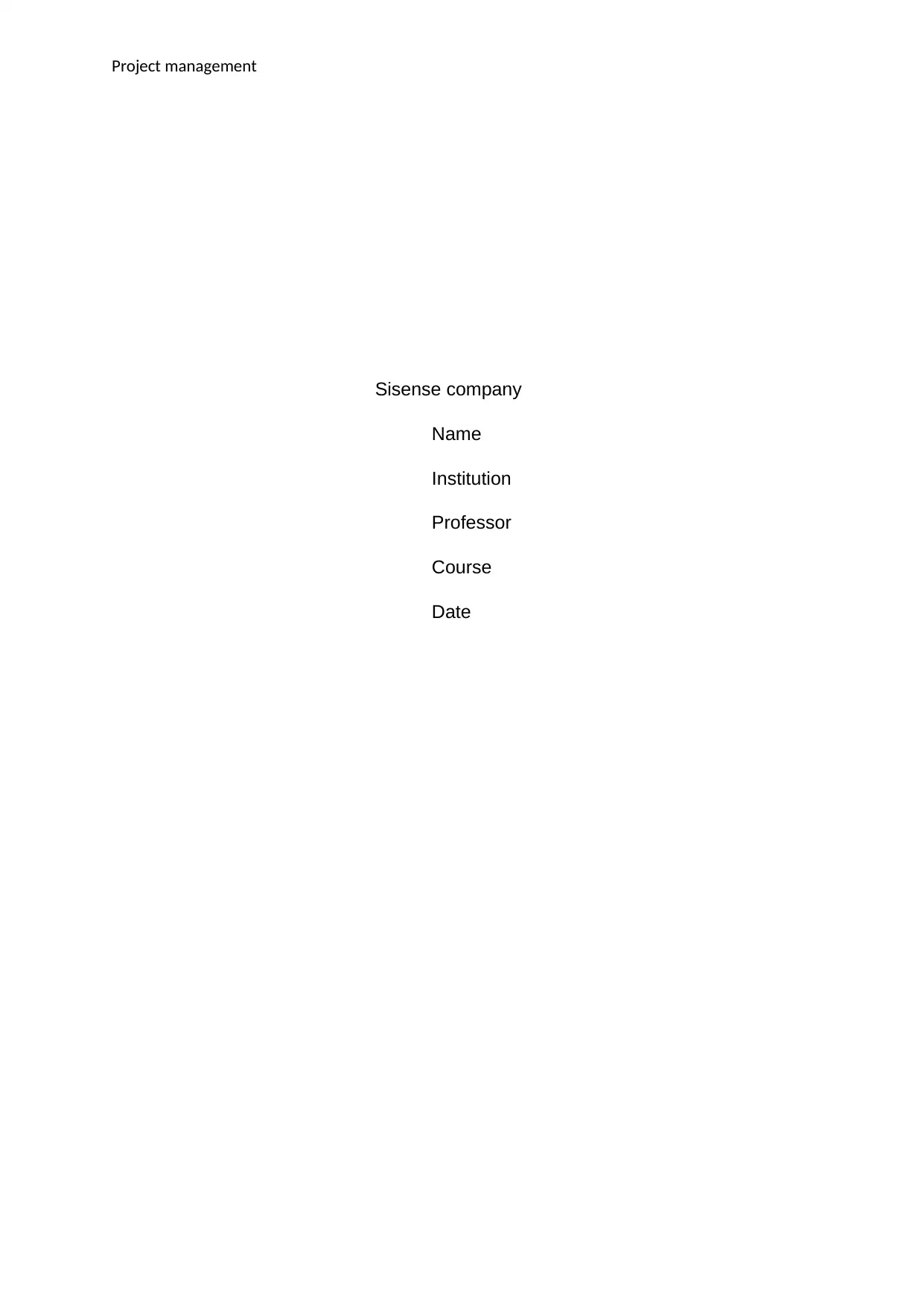
Project management
Sisense company
Name
Institution
Professor
Course
Date
Sisense company
Name
Institution
Professor
Course
Date
Secure Best Marks with AI Grader
Need help grading? Try our AI Grader for instant feedback on your assignments.
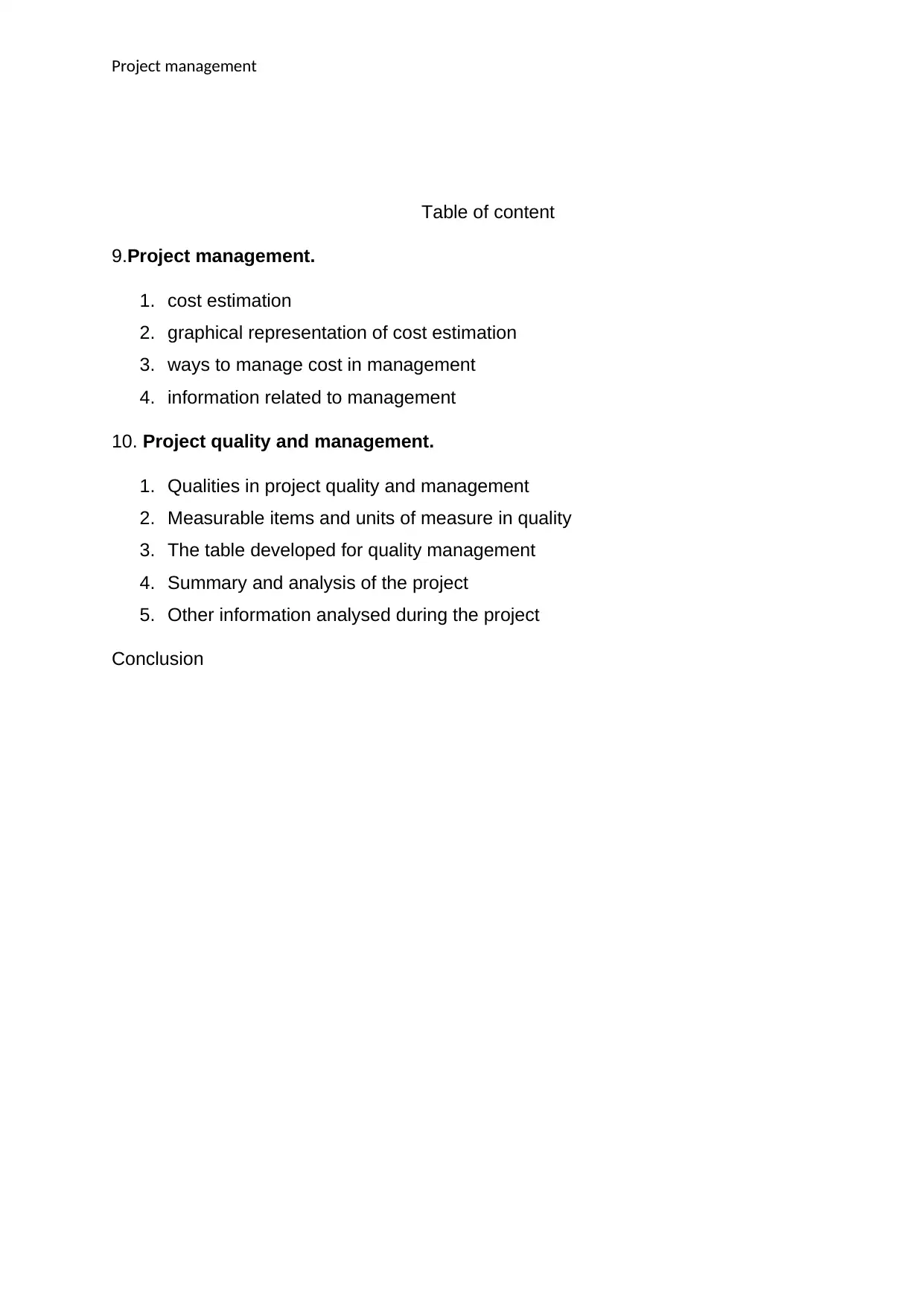
Project management
Table of content
9.Project management.
1. cost estimation
2. graphical representation of cost estimation
3. ways to manage cost in management
4. information related to management
10. Project quality and management.
1. Qualities in project quality and management
2. Measurable items and units of measure in quality
3. The table developed for quality management
4. Summary and analysis of the project
5. Other information analysed during the project
Conclusion
Table of content
9.Project management.
1. cost estimation
2. graphical representation of cost estimation
3. ways to manage cost in management
4. information related to management
10. Project quality and management.
1. Qualities in project quality and management
2. Measurable items and units of measure in quality
3. The table developed for quality management
4. Summary and analysis of the project
5. Other information analysed during the project
Conclusion
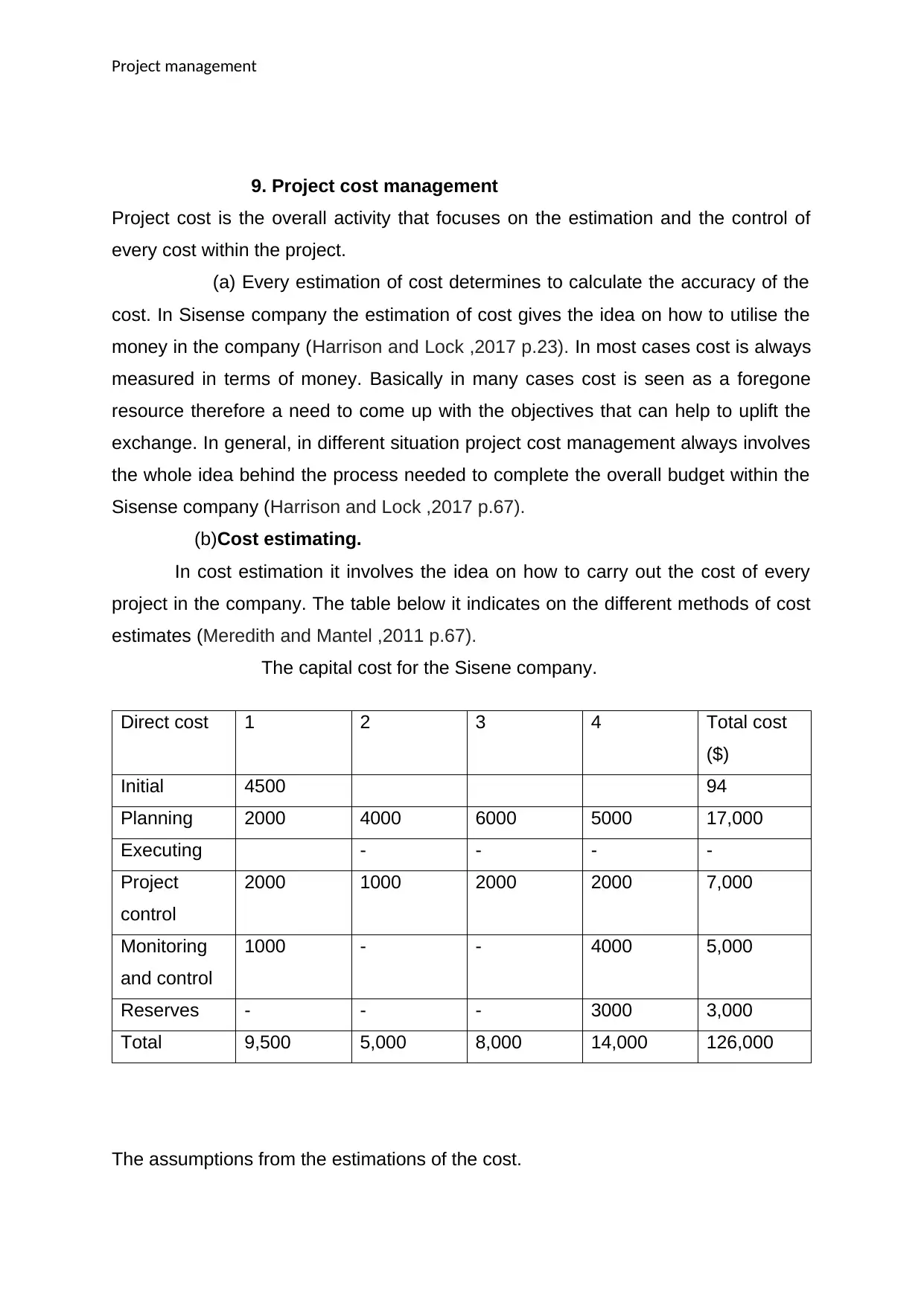
Project management
9. Project cost management
Project cost is the overall activity that focuses on the estimation and the control of
every cost within the project.
(a) Every estimation of cost determines to calculate the accuracy of the
cost. In Sisense company the estimation of cost gives the idea on how to utilise the
money in the company (Harrison and Lock ,2017 p.23). In most cases cost is always
measured in terms of money. Basically in many cases cost is seen as a foregone
resource therefore a need to come up with the objectives that can help to uplift the
exchange. In general, in different situation project cost management always involves
the whole idea behind the process needed to complete the overall budget within the
Sisense company (Harrison and Lock ,2017 p.67).
(b)Cost estimating.
In cost estimation it involves the idea on how to carry out the cost of every
project in the company. The table below it indicates on the different methods of cost
estimates (Meredith and Mantel ,2011 p.67).
The capital cost for the Sisene company.
Direct cost 1 2 3 4 Total cost
($)
Initial 4500 94
Planning 2000 4000 6000 5000 17,000
Executing - - - -
Project
control
2000 1000 2000 2000 7,000
Monitoring
and control
1000 - - 4000 5,000
Reserves - - - 3000 3,000
Total 9,500 5,000 8,000 14,000 126,000
The assumptions from the estimations of the cost.
9. Project cost management
Project cost is the overall activity that focuses on the estimation and the control of
every cost within the project.
(a) Every estimation of cost determines to calculate the accuracy of the
cost. In Sisense company the estimation of cost gives the idea on how to utilise the
money in the company (Harrison and Lock ,2017 p.23). In most cases cost is always
measured in terms of money. Basically in many cases cost is seen as a foregone
resource therefore a need to come up with the objectives that can help to uplift the
exchange. In general, in different situation project cost management always involves
the whole idea behind the process needed to complete the overall budget within the
Sisense company (Harrison and Lock ,2017 p.67).
(b)Cost estimating.
In cost estimation it involves the idea on how to carry out the cost of every
project in the company. The table below it indicates on the different methods of cost
estimates (Meredith and Mantel ,2011 p.67).
The capital cost for the Sisene company.
Direct cost 1 2 3 4 Total cost
($)
Initial 4500 94
Planning 2000 4000 6000 5000 17,000
Executing - - - -
Project
control
2000 1000 2000 2000 7,000
Monitoring
and control
1000 - - 4000 5,000
Reserves - - - 3000 3,000
Total 9,500 5,000 8,000 14,000 126,000
The assumptions from the estimations of the cost.
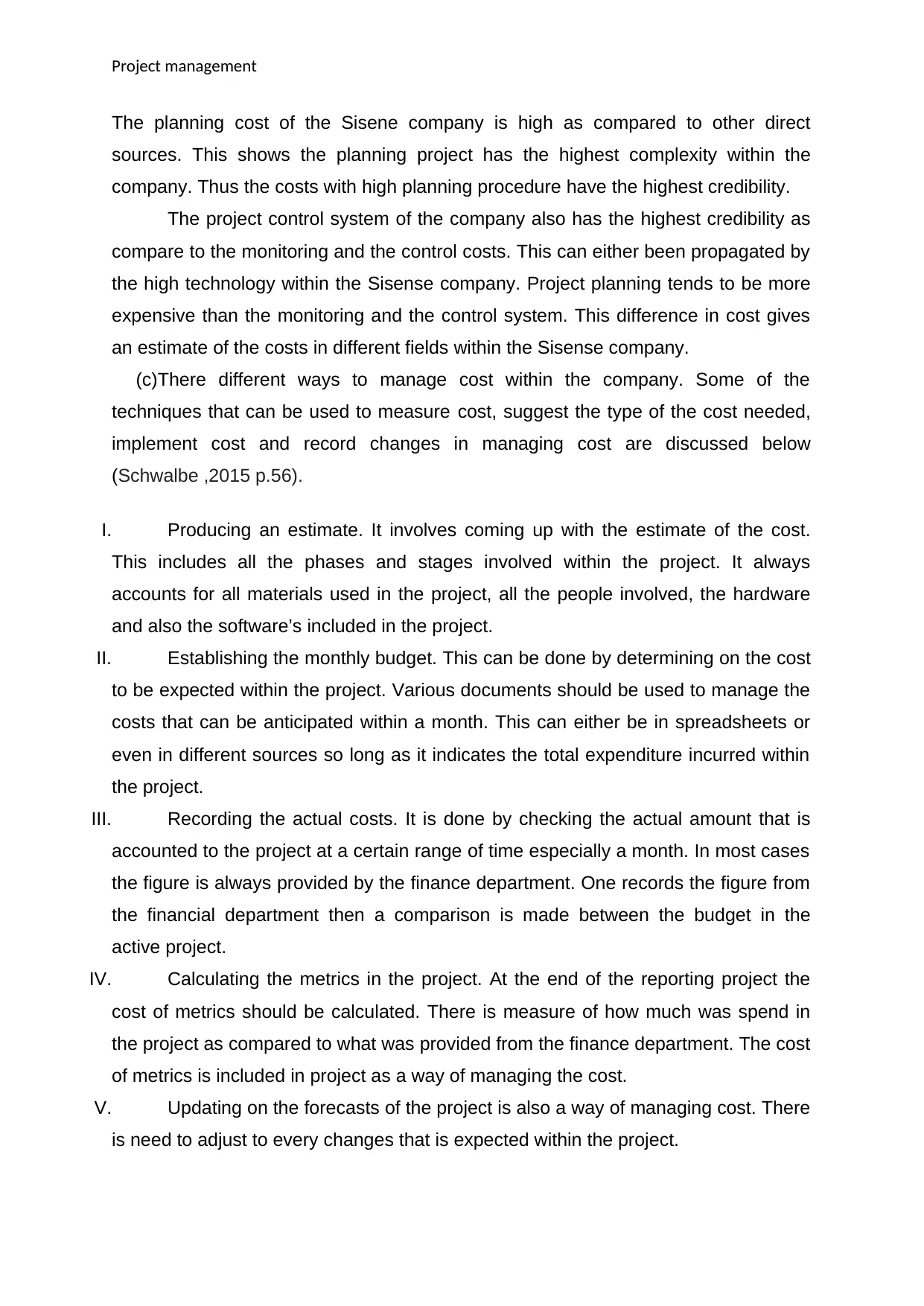
Project management
The planning cost of the Sisene company is high as compared to other direct
sources. This shows the planning project has the highest complexity within the
company. Thus the costs with high planning procedure have the highest credibility.
The project control system of the company also has the highest credibility as
compare to the monitoring and the control costs. This can either been propagated by
the high technology within the Sisense company. Project planning tends to be more
expensive than the monitoring and the control system. This difference in cost gives
an estimate of the costs in different fields within the Sisense company.
(c)There different ways to manage cost within the company. Some of the
techniques that can be used to measure cost, suggest the type of the cost needed,
implement cost and record changes in managing cost are discussed below
(Schwalbe ,2015 p.56).
I. Producing an estimate. It involves coming up with the estimate of the cost.
This includes all the phases and stages involved within the project. It always
accounts for all materials used in the project, all the people involved, the hardware
and also the software’s included in the project.
II. Establishing the monthly budget. This can be done by determining on the cost
to be expected within the project. Various documents should be used to manage the
costs that can be anticipated within a month. This can either be in spreadsheets or
even in different sources so long as it indicates the total expenditure incurred within
the project.
III. Recording the actual costs. It is done by checking the actual amount that is
accounted to the project at a certain range of time especially a month. In most cases
the figure is always provided by the finance department. One records the figure from
the financial department then a comparison is made between the budget in the
active project.
IV. Calculating the metrics in the project. At the end of the reporting project the
cost of metrics should be calculated. There is measure of how much was spend in
the project as compared to what was provided from the finance department. The cost
of metrics is included in project as a way of managing the cost.
V. Updating on the forecasts of the project is also a way of managing cost. There
is need to adjust to every changes that is expected within the project.
The planning cost of the Sisene company is high as compared to other direct
sources. This shows the planning project has the highest complexity within the
company. Thus the costs with high planning procedure have the highest credibility.
The project control system of the company also has the highest credibility as
compare to the monitoring and the control costs. This can either been propagated by
the high technology within the Sisense company. Project planning tends to be more
expensive than the monitoring and the control system. This difference in cost gives
an estimate of the costs in different fields within the Sisense company.
(c)There different ways to manage cost within the company. Some of the
techniques that can be used to measure cost, suggest the type of the cost needed,
implement cost and record changes in managing cost are discussed below
(Schwalbe ,2015 p.56).
I. Producing an estimate. It involves coming up with the estimate of the cost.
This includes all the phases and stages involved within the project. It always
accounts for all materials used in the project, all the people involved, the hardware
and also the software’s included in the project.
II. Establishing the monthly budget. This can be done by determining on the cost
to be expected within the project. Various documents should be used to manage the
costs that can be anticipated within a month. This can either be in spreadsheets or
even in different sources so long as it indicates the total expenditure incurred within
the project.
III. Recording the actual costs. It is done by checking the actual amount that is
accounted to the project at a certain range of time especially a month. In most cases
the figure is always provided by the finance department. One records the figure from
the financial department then a comparison is made between the budget in the
active project.
IV. Calculating the metrics in the project. At the end of the reporting project the
cost of metrics should be calculated. There is measure of how much was spend in
the project as compared to what was provided from the finance department. The cost
of metrics is included in project as a way of managing the cost.
V. Updating on the forecasts of the project is also a way of managing cost. There
is need to adjust to every changes that is expected within the project.
Secure Best Marks with AI Grader
Need help grading? Try our AI Grader for instant feedback on your assignments.
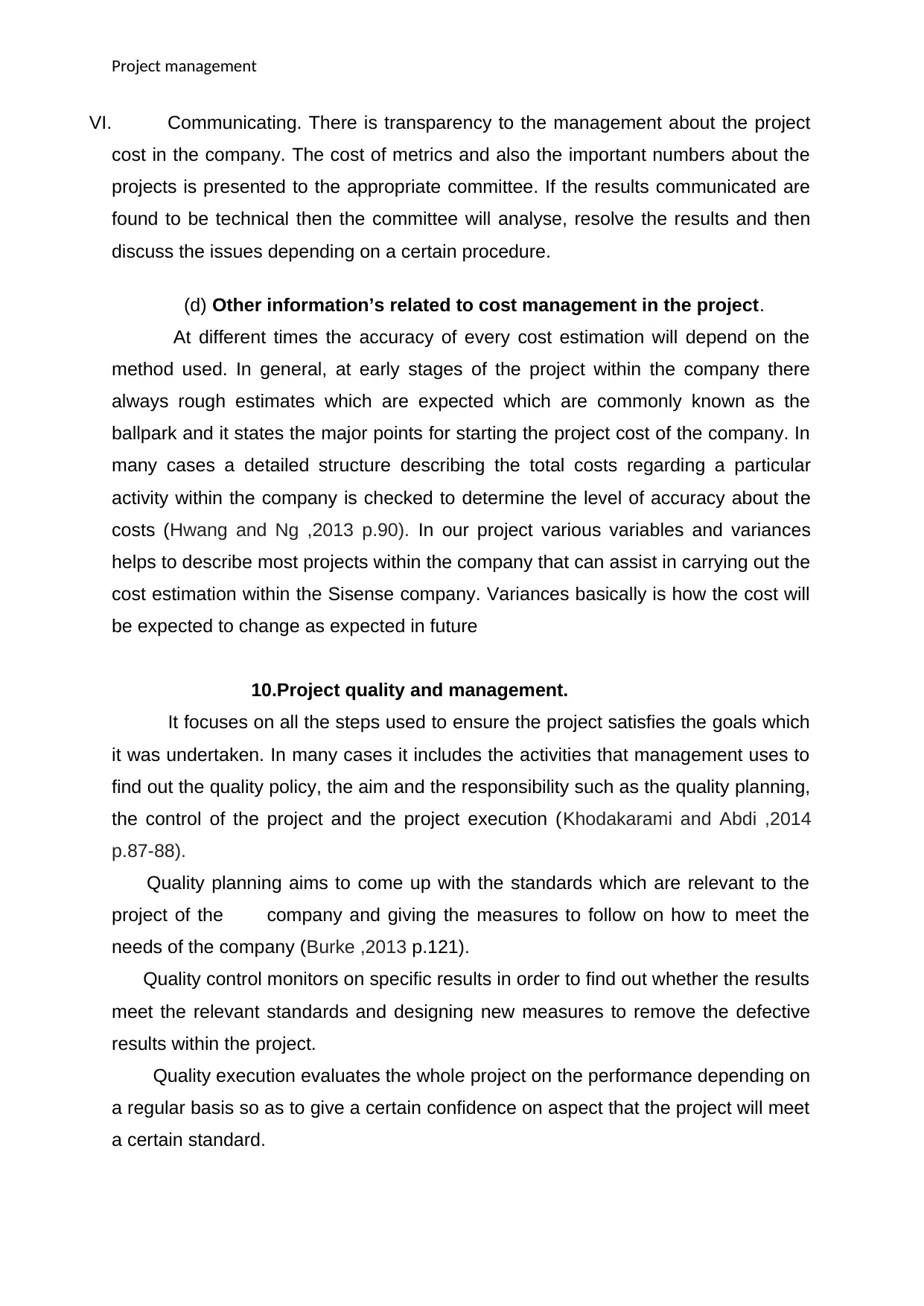
Project management
VI. Communicating. There is transparency to the management about the project
cost in the company. The cost of metrics and also the important numbers about the
projects is presented to the appropriate committee. If the results communicated are
found to be technical then the committee will analyse, resolve the results and then
discuss the issues depending on a certain procedure.
(d) Other information’s related to cost management in the project.
At different times the accuracy of every cost estimation will depend on the
method used. In general, at early stages of the project within the company there
always rough estimates which are expected which are commonly known as the
ballpark and it states the major points for starting the project cost of the company. In
many cases a detailed structure describing the total costs regarding a particular
activity within the company is checked to determine the level of accuracy about the
costs (Hwang and Ng ,2013 p.90). In our project various variables and variances
helps to describe most projects within the company that can assist in carrying out the
cost estimation within the Sisense company. Variances basically is how the cost will
be expected to change as expected in future
10.Project quality and management.
It focuses on all the steps used to ensure the project satisfies the goals which
it was undertaken. In many cases it includes the activities that management uses to
find out the quality policy, the aim and the responsibility such as the quality planning,
the control of the project and the project execution (Khodakarami and Abdi ,2014
p.87-88).
Quality planning aims to come up with the standards which are relevant to the
project of the company and giving the measures to follow on how to meet the
needs of the company (Burke ,2013 p.121).
Quality control monitors on specific results in order to find out whether the results
meet the relevant standards and designing new measures to remove the defective
results within the project.
Quality execution evaluates the whole project on the performance depending on
a regular basis so as to give a certain confidence on aspect that the project will meet
a certain standard.
VI. Communicating. There is transparency to the management about the project
cost in the company. The cost of metrics and also the important numbers about the
projects is presented to the appropriate committee. If the results communicated are
found to be technical then the committee will analyse, resolve the results and then
discuss the issues depending on a certain procedure.
(d) Other information’s related to cost management in the project.
At different times the accuracy of every cost estimation will depend on the
method used. In general, at early stages of the project within the company there
always rough estimates which are expected which are commonly known as the
ballpark and it states the major points for starting the project cost of the company. In
many cases a detailed structure describing the total costs regarding a particular
activity within the company is checked to determine the level of accuracy about the
costs (Hwang and Ng ,2013 p.90). In our project various variables and variances
helps to describe most projects within the company that can assist in carrying out the
cost estimation within the Sisense company. Variances basically is how the cost will
be expected to change as expected in future
10.Project quality and management.
It focuses on all the steps used to ensure the project satisfies the goals which
it was undertaken. In many cases it includes the activities that management uses to
find out the quality policy, the aim and the responsibility such as the quality planning,
the control of the project and the project execution (Khodakarami and Abdi ,2014
p.87-88).
Quality planning aims to come up with the standards which are relevant to the
project of the company and giving the measures to follow on how to meet the
needs of the company (Burke ,2013 p.121).
Quality control monitors on specific results in order to find out whether the results
meet the relevant standards and designing new measures to remove the defective
results within the project.
Quality execution evaluates the whole project on the performance depending on
a regular basis so as to give a certain confidence on aspect that the project will meet
a certain standard.
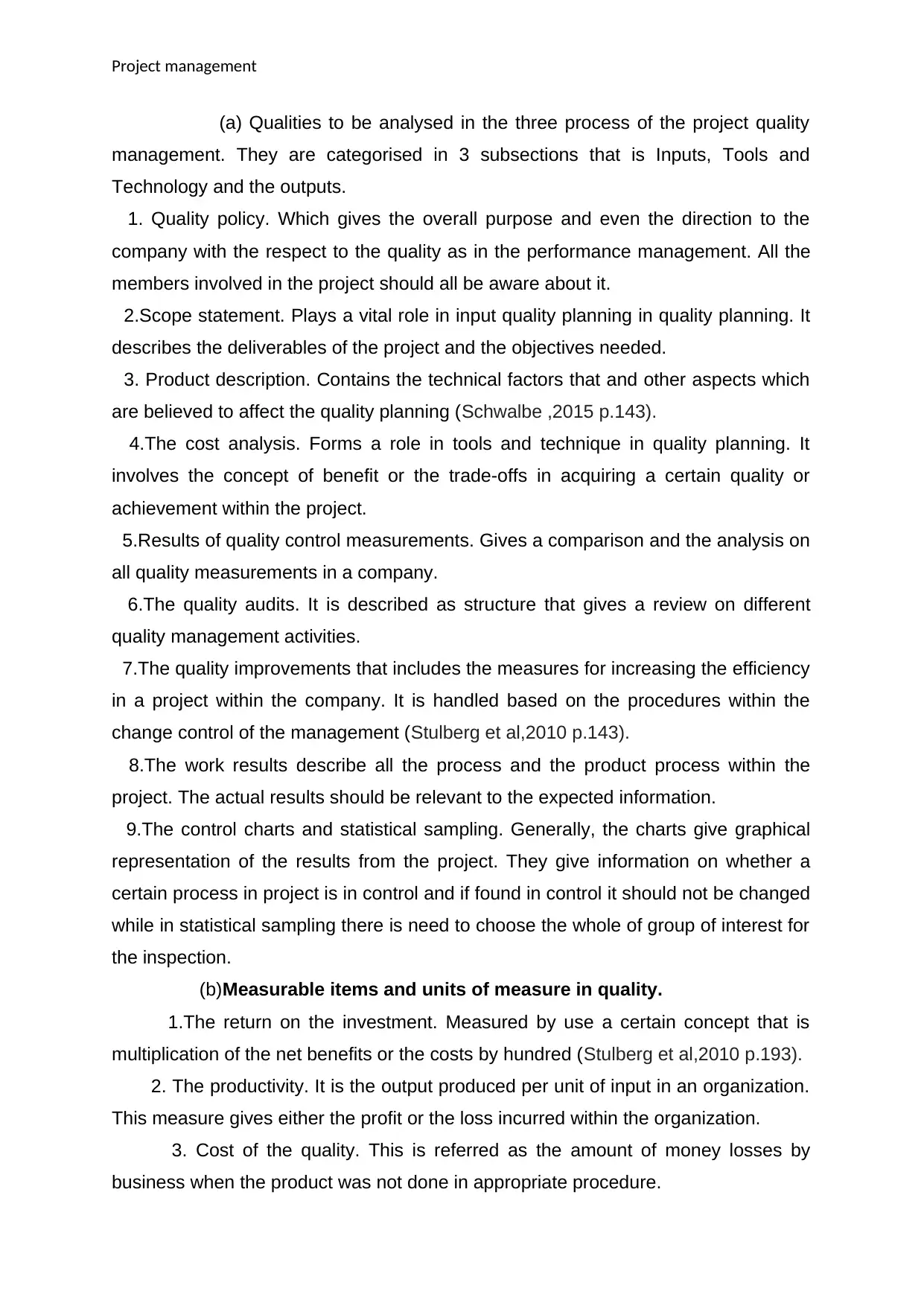
Project management
(a) Qualities to be analysed in the three process of the project quality
management. They are categorised in 3 subsections that is Inputs, Tools and
Technology and the outputs.
1. Quality policy. Which gives the overall purpose and even the direction to the
company with the respect to the quality as in the performance management. All the
members involved in the project should all be aware about it.
2.Scope statement. Plays a vital role in input quality planning in quality planning. It
describes the deliverables of the project and the objectives needed.
3. Product description. Contains the technical factors that and other aspects which
are believed to affect the quality planning (Schwalbe ,2015 p.143).
4.The cost analysis. Forms a role in tools and technique in quality planning. It
involves the concept of benefit or the trade-offs in acquiring a certain quality or
achievement within the project.
5.Results of quality control measurements. Gives a comparison and the analysis on
all quality measurements in a company.
6.The quality audits. It is described as structure that gives a review on different
quality management activities.
7.The quality improvements that includes the measures for increasing the efficiency
in a project within the company. It is handled based on the procedures within the
change control of the management (Stulberg et al,2010 p.143).
8.The work results describe all the process and the product process within the
project. The actual results should be relevant to the expected information.
9.The control charts and statistical sampling. Generally, the charts give graphical
representation of the results from the project. They give information on whether a
certain process in project is in control and if found in control it should not be changed
while in statistical sampling there is need to choose the whole of group of interest for
the inspection.
(b)Measurable items and units of measure in quality.
1.The return on the investment. Measured by use a certain concept that is
multiplication of the net benefits or the costs by hundred (Stulberg et al,2010 p.193).
2. The productivity. It is the output produced per unit of input in an organization.
This measure gives either the profit or the loss incurred within the organization.
3. Cost of the quality. This is referred as the amount of money losses by
business when the product was not done in appropriate procedure.
(a) Qualities to be analysed in the three process of the project quality
management. They are categorised in 3 subsections that is Inputs, Tools and
Technology and the outputs.
1. Quality policy. Which gives the overall purpose and even the direction to the
company with the respect to the quality as in the performance management. All the
members involved in the project should all be aware about it.
2.Scope statement. Plays a vital role in input quality planning in quality planning. It
describes the deliverables of the project and the objectives needed.
3. Product description. Contains the technical factors that and other aspects which
are believed to affect the quality planning (Schwalbe ,2015 p.143).
4.The cost analysis. Forms a role in tools and technique in quality planning. It
involves the concept of benefit or the trade-offs in acquiring a certain quality or
achievement within the project.
5.Results of quality control measurements. Gives a comparison and the analysis on
all quality measurements in a company.
6.The quality audits. It is described as structure that gives a review on different
quality management activities.
7.The quality improvements that includes the measures for increasing the efficiency
in a project within the company. It is handled based on the procedures within the
change control of the management (Stulberg et al,2010 p.143).
8.The work results describe all the process and the product process within the
project. The actual results should be relevant to the expected information.
9.The control charts and statistical sampling. Generally, the charts give graphical
representation of the results from the project. They give information on whether a
certain process in project is in control and if found in control it should not be changed
while in statistical sampling there is need to choose the whole of group of interest for
the inspection.
(b)Measurable items and units of measure in quality.
1.The return on the investment. Measured by use a certain concept that is
multiplication of the net benefits or the costs by hundred (Stulberg et al,2010 p.193).
2. The productivity. It is the output produced per unit of input in an organization.
This measure gives either the profit or the loss incurred within the organization.
3. Cost of the quality. This is referred as the amount of money losses by
business when the product was not done in appropriate procedure.
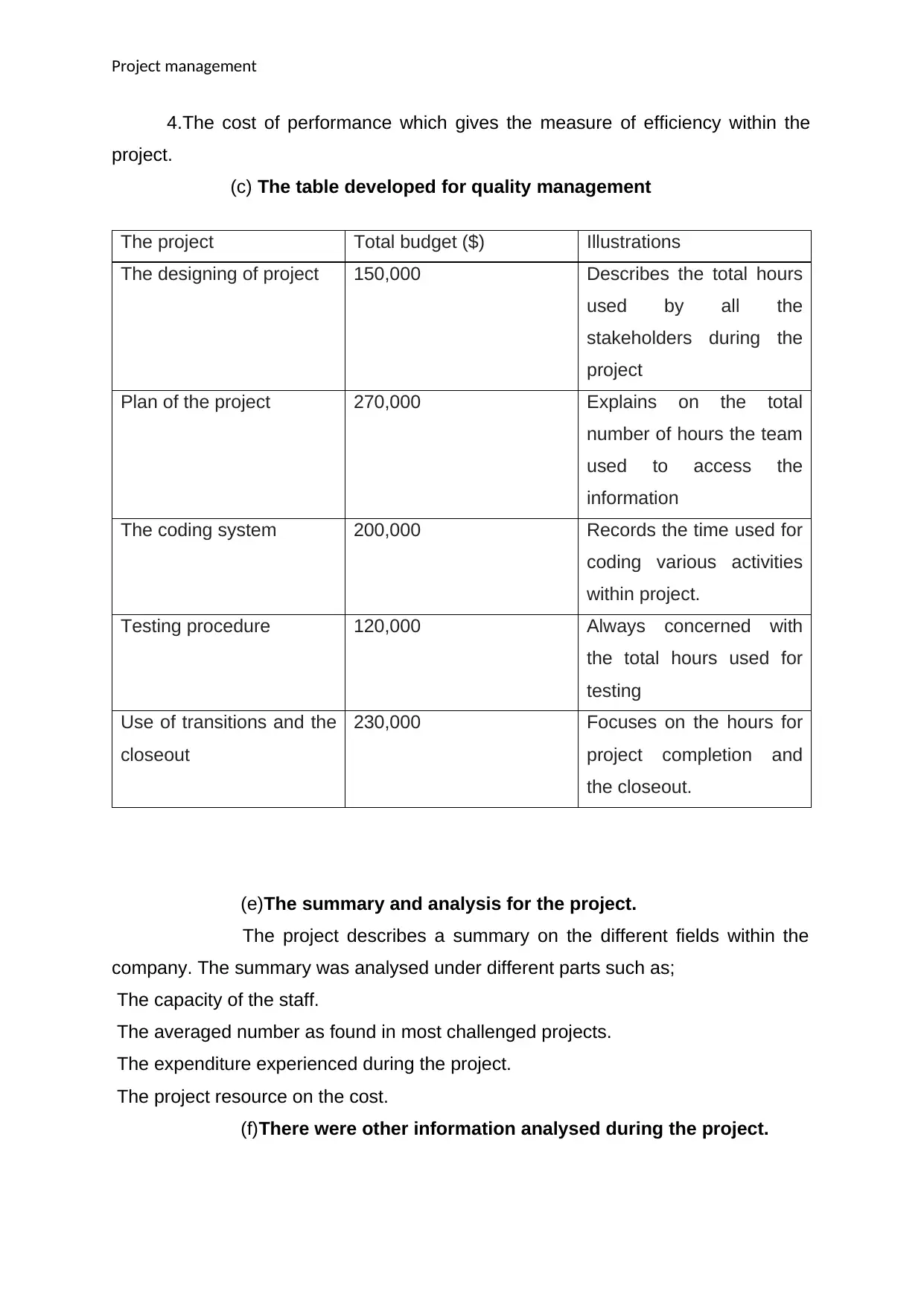
Project management
4.The cost of performance which gives the measure of efficiency within the
project.
(c) The table developed for quality management
The project Total budget ($) Illustrations
The designing of project 150,000 Describes the total hours
used by all the
stakeholders during the
project
Plan of the project 270,000 Explains on the total
number of hours the team
used to access the
information
The coding system 200,000 Records the time used for
coding various activities
within project.
Testing procedure 120,000 Always concerned with
the total hours used for
testing
Use of transitions and the
closeout
230,000 Focuses on the hours for
project completion and
the closeout.
(e)The summary and analysis for the project.
The project describes a summary on the different fields within the
company. The summary was analysed under different parts such as;
The capacity of the staff.
The averaged number as found in most challenged projects.
The expenditure experienced during the project.
The project resource on the cost.
(f)There were other information analysed during the project.
4.The cost of performance which gives the measure of efficiency within the
project.
(c) The table developed for quality management
The project Total budget ($) Illustrations
The designing of project 150,000 Describes the total hours
used by all the
stakeholders during the
project
Plan of the project 270,000 Explains on the total
number of hours the team
used to access the
information
The coding system 200,000 Records the time used for
coding various activities
within project.
Testing procedure 120,000 Always concerned with
the total hours used for
testing
Use of transitions and the
closeout
230,000 Focuses on the hours for
project completion and
the closeout.
(e)The summary and analysis for the project.
The project describes a summary on the different fields within the
company. The summary was analysed under different parts such as;
The capacity of the staff.
The averaged number as found in most challenged projects.
The expenditure experienced during the project.
The project resource on the cost.
(f)There were other information analysed during the project.
Paraphrase This Document
Need a fresh take? Get an instant paraphrase of this document with our AI Paraphraser
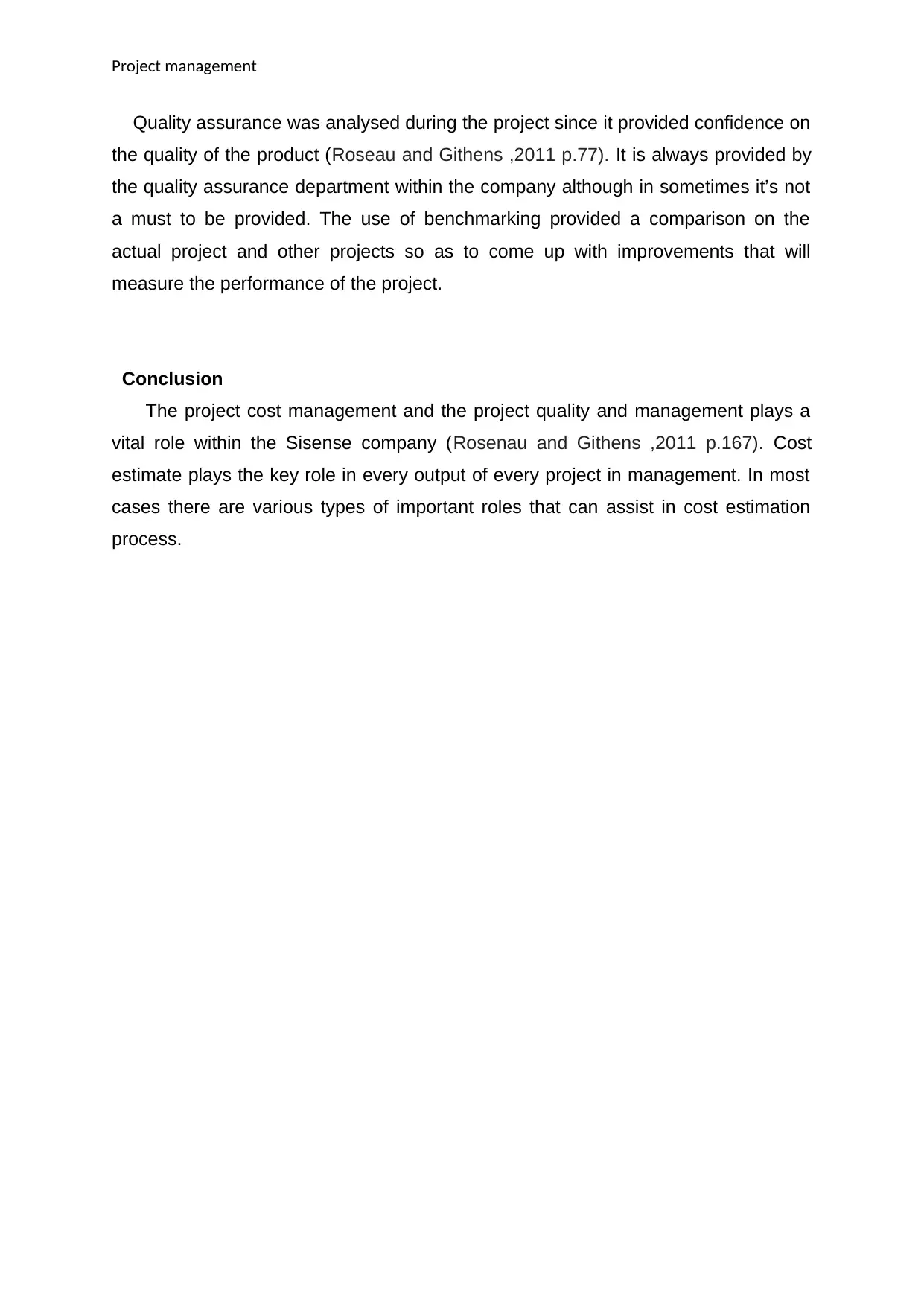
Project management
Quality assurance was analysed during the project since it provided confidence on
the quality of the product (Roseau and Githens ,2011 p.77). It is always provided by
the quality assurance department within the company although in sometimes it’s not
a must to be provided. The use of benchmarking provided a comparison on the
actual project and other projects so as to come up with improvements that will
measure the performance of the project.
Conclusion
The project cost management and the project quality and management plays a
vital role within the Sisense company (Rosenau and Githens ,2011 p.167). Cost
estimate plays the key role in every output of every project in management. In most
cases there are various types of important roles that can assist in cost estimation
process.
Quality assurance was analysed during the project since it provided confidence on
the quality of the product (Roseau and Githens ,2011 p.77). It is always provided by
the quality assurance department within the company although in sometimes it’s not
a must to be provided. The use of benchmarking provided a comparison on the
actual project and other projects so as to come up with improvements that will
measure the performance of the project.
Conclusion
The project cost management and the project quality and management plays a
vital role within the Sisense company (Rosenau and Githens ,2011 p.167). Cost
estimate plays the key role in every output of every project in management. In most
cases there are various types of important roles that can assist in cost estimation
process.
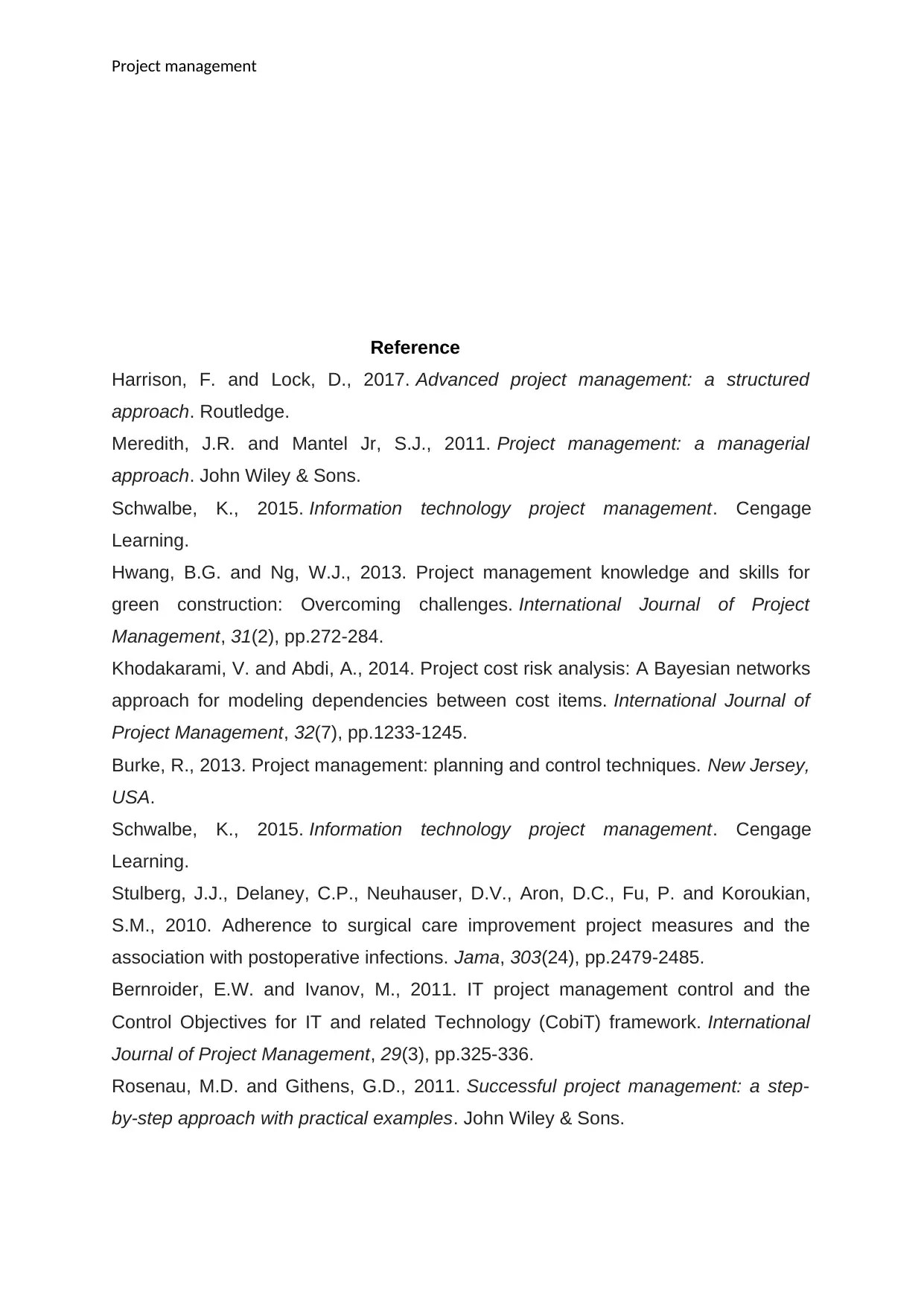
Project management
Reference
Harrison, F. and Lock, D., 2017. Advanced project management: a structured
approach. Routledge.
Meredith, J.R. and Mantel Jr, S.J., 2011. Project management: a managerial
approach. John Wiley & Sons.
Schwalbe, K., 2015. Information technology project management. Cengage
Learning.
Hwang, B.G. and Ng, W.J., 2013. Project management knowledge and skills for
green construction: Overcoming challenges. International Journal of Project
Management, 31(2), pp.272-284.
Khodakarami, V. and Abdi, A., 2014. Project cost risk analysis: A Bayesian networks
approach for modeling dependencies between cost items. International Journal of
Project Management, 32(7), pp.1233-1245.
Burke, R., 2013. Project management: planning and control techniques. New Jersey,
USA.
Schwalbe, K., 2015. Information technology project management. Cengage
Learning.
Stulberg, J.J., Delaney, C.P., Neuhauser, D.V., Aron, D.C., Fu, P. and Koroukian,
S.M., 2010. Adherence to surgical care improvement project measures and the
association with postoperative infections. Jama, 303(24), pp.2479-2485.
Bernroider, E.W. and Ivanov, M., 2011. IT project management control and the
Control Objectives for IT and related Technology (CobiT) framework. International
Journal of Project Management, 29(3), pp.325-336.
Rosenau, M.D. and Githens, G.D., 2011. Successful project management: a step-
by-step approach with practical examples. John Wiley & Sons.
Reference
Harrison, F. and Lock, D., 2017. Advanced project management: a structured
approach. Routledge.
Meredith, J.R. and Mantel Jr, S.J., 2011. Project management: a managerial
approach. John Wiley & Sons.
Schwalbe, K., 2015. Information technology project management. Cengage
Learning.
Hwang, B.G. and Ng, W.J., 2013. Project management knowledge and skills for
green construction: Overcoming challenges. International Journal of Project
Management, 31(2), pp.272-284.
Khodakarami, V. and Abdi, A., 2014. Project cost risk analysis: A Bayesian networks
approach for modeling dependencies between cost items. International Journal of
Project Management, 32(7), pp.1233-1245.
Burke, R., 2013. Project management: planning and control techniques. New Jersey,
USA.
Schwalbe, K., 2015. Information technology project management. Cengage
Learning.
Stulberg, J.J., Delaney, C.P., Neuhauser, D.V., Aron, D.C., Fu, P. and Koroukian,
S.M., 2010. Adherence to surgical care improvement project measures and the
association with postoperative infections. Jama, 303(24), pp.2479-2485.
Bernroider, E.W. and Ivanov, M., 2011. IT project management control and the
Control Objectives for IT and related Technology (CobiT) framework. International
Journal of Project Management, 29(3), pp.325-336.
Rosenau, M.D. and Githens, G.D., 2011. Successful project management: a step-
by-step approach with practical examples. John Wiley & Sons.
1 out of 9
Related Documents
Your All-in-One AI-Powered Toolkit for Academic Success.
+13062052269
info@desklib.com
Available 24*7 on WhatsApp / Email
![[object Object]](/_next/static/media/star-bottom.7253800d.svg)
Unlock your academic potential
© 2024 | Zucol Services PVT LTD | All rights reserved.





